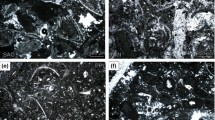Abstract
The gray and white crystalline limestones from Agios Panteleimonas Florina have almost the same mineralogical composition. They are mainly composed of calcite (96%), while the percentage of the contained organic matter is 0.8% in the gray and 0.09% in the white crystalline limestone. After heating both crystalline limestones at 500°C no serious change was observed concerning their mineralogical composition. However, the velocity of P waves and the porosity in the gray limestone are changed significantly while this trend is not noticed in the white limestone. These changes are mainly attributed to the burning of organic matter, which is contained with greater percentage in the gray crystalline limestone. At 1000°C both crystalline limestones are completely calcined. The dissociation of calcite and dolomite increases significantly the porosity of the produced quicklime. The quicklime from gray crystalline limestone presents higher porosity value (by 5.2 percentage units) and it is more reactive (by 4.9 percentage units) in comparison with the quicklime from white crystalline limestone. This difference in the reactivity is mainly attributed to the difference in the percentage of organic matter contained in the two crystalline limestones.
Résumé
Les calcaires cristallins, gris et blancs, de Agios Panteleimonas Florinas, ont à peu près la même composition minéralogique. Ils sont composés essentiellement de calcite (96%), tandis que le pourcentage de la matière organique contenue est de 0,8% dans le gris et 0,09% dans le calcaire cristallin blanc. Le chauffage de ces deux calcaires cristallins à 500°C n’apporte aucun sérieux changement concernant leur composition minéralogique. Toutefois, la vitesse des ondes P et la porosité du calcaire gris ont considérablement changé, tandis que cette tendance n’est pas notée dans le calcaire blanc. Ces changements sont attribués à la combustion de la matière organique, dont le pourcentage est plus élevé dans le calcaire cristallin gris. À 1000°C les deux calcaires cristallins sont complètement calcinés. La destruction de la calcite et de la dolomite augmente considérablement la porosité de l’asbeste produit. L’asbeste produit par le calcaire cristallin gris présente une valeur de porosité supérieure de 5,2% et il est plus réactif (de 4,9%) en comparaison avec l’asbeste produit par le calcaire cristallin blanc. Cette différence de réactivité est essentiellement attribuée à la différence du pourcentage de matière organique contenue dans les deux calcaires cristallins.
Similar content being viewed by others
References
Boynton, R. S., ‘Chemistry and Technology of Limestone’, 2nd edn. (Wiley & Sons, New York, 1980).
Oates, J. A. H., ‘Lime and limestone. Chemistry and technology, production and uses’ (Wiley-VCH, Weinheim, 1998).
Pavlides, S., ‘Neotectonic evolution of the Florina-Vegoritis-Ptolemais Basin (W. Macedonia)’, PhD Thesis (Aristotle University, Thessaloniki, 1985) (in Greek with English abstract).
Kantiranis, N., ‘Petrological, geochemical and technological study of the Jurassic carbonate rocks from Agios Panteleimonas, Florina, Macedonia, Greece’, MSc Thesis (Aristotle University, Thessaloniki, 1998) (in Greek with English abstract).
Jackson, M. L., ‘Soil chemical analysis-Adv. Course’, 2nd edn. 11th printing, (Madison, WI, 1974).
AASHO T-147, ‘The classification of soils and soil-aggregate mixtures for highway construction purposes’, in ‘Standard Specifications for Highway Materials and Methods of Sampling and Testing’ (Am. Assoc. State Highway Officials, Part 1, Specific., 1961) 45–51.
ASTM C-29, ‘Standard test methods for unit weight and voids in aggregate’, Annual Book of ASTM Standards 04.01 (1991) 1–4.
AFNOR NF B 10505, ‘Produits de carrières—Pierres calcaires—Mesure de la vitesse de propagation du son (ondes longitudinales)’ (1973).
Wyllie, M. R. J., Gregory, A. R. and Gardner, G. H. F., ‘An experimental investigation of factors affecting elastic wave velocities in porous media’,Geophysics 23 (1958) 459–469.
DIN 19611,‘High-calcium lime for use in water treatment’ (1983).
Gutschick, K. A., ‘Lime and Limestone’, in ‘Howe-Grant M. (Ed.) Encyclopedia of Chemical Technology’, (Wiley & Sons, New York, 1995) 15, 319–359.
Deer, W. H., Howie, R. A. and Zussman, J., ‘Rock-forming minerals, Vol. 3: Sheet silicates’, (Longmans, London, 1962).
Kantiranis, N., Filippidis, A., Tsirambides, A., Christaras, B. and Kassoli-Fournaraki, A., ‘Volatilization of arsenic during calcination of crystalline limestone for Agios Panteleimonas, Florina, Macedonia, Greece’, Proceedings of Fourth International Conference on Environmental Pollution Toxic Metals, Thessaloniki, Sept. 1998 (Aristotle University, Thessaloniki, 1998) 73–78.
Kantiranis, N., Tsirambides, A., Filippidis, A. and Christaras, B., ‘Technological characteristics of the calcined limestone from Agios Panteleimonas, Macedonia, Greece’,Mater. Struct. 32 (1999) 546–551.
Irfan, T. W. and Dearman, W. R., ‘Engineering classification and index properties of a weathered granite’,IAEG Bull. 17 (1978) 79–90.
Auger, F., ‘Influence des fluides interstitiels sur la vitesse du son dans les matériaux de construction. Mesures expérimentales et conséquences sur les diagnostics d’altérabilité’, Intern. Measurm. Testing Civil Engin.., Lyon, (1988) 259–268.
Christaras, B., ‘Anisotropy effects on the elastic parameters of rocks; determination using ultrasonic techniques’,Bull. Geol. Soc. Greece 30 (4) (1994) 381–387.
Christaras, B., Auger, F. and Mosse, E., ‘Determination of the elastic moduli of rocks. Comparison of the ultrasonic velocity and mechanical resonance frequency methods to the direct static one’,Mater. Struct. 27 (1994) 222–228.
Topal, T., ‘Ultrasonic testing of artificially weathered Cappadocian tuff’, in ‘Preservation Restorations Cultural Heritage’, Proceedings of Congress LCP’95, Montreux (1995) 205–212.
Hamrol, A., ‘A quantitative classification of the weathering and weatherability of rocks’, Proceedings of 5th International Conference Soil Mechanics Foundation Engineering, Paris (1961) 771–774.
Hughes, D. S. and Maurette, C., ‘Variation of elastic wave velocities in basic rocks with pressure and temperature’,Geophysics 22 (1957) 23–32.
Timur, A., ‘Temperature dependence of compressional and shear wave velocities in rocks’,Geophysics 42 (1997) 950–956.
Toksoz, M. N., Cheng, C. H. and Timur, A., ‘Velocities of seismic waves in porous rocks’,Geophysics 41 (1976) 621–645.
Author information
Authors and Affiliations
Additional information
Note Editorial The Aristote University of Thessaloniki is a RILEM Associate Member.
Rights and permissions
About this article
Cite this article
Kantiranis, N., Filippidis, A., Christaras, B. et al. The role of organic matter of carbonate rocks in the reactivity of the produced quicklime. Mat. Struct. 36, 135–138 (2003). https://doi.org/10.1007/BF02479527
Received:
Accepted:
Issue Date:
DOI: https://doi.org/10.1007/BF02479527




